8 Trees Native to Washington State
BY CECILIA ACEVEDO | MAY 29TH, 2023 | LAWN CARE, WASHINGTONWithin the picturesque landscapes of Washington State, a realm of natural treasures awaits. Here, native trees proudly stand as guardians of the land, their roots firmly grounded in this diverse region. These majestic trees native to Washington State offer many advantages, providing a food source for wildlife and a source of inspiration for the vibrant culture that thrives throughout the state.
From the towering forests of Olympic National Park to the urban arboreal havens of Seattle and Tacoma, Washington’s native trees add a distinct flavor to each cityscape, infusing the air with a crisp freshness that invigorates both body and spirit.
In this article, we’ll cover the following:
- 8 Trees Native to Washington State
- FAQ About Trees Native to Washington State
- Where to Find Native Trees and Plants in Washington State
8 Trees Native to Washington State
1. Douglas Fir (Pseudotsuga Menziesii)
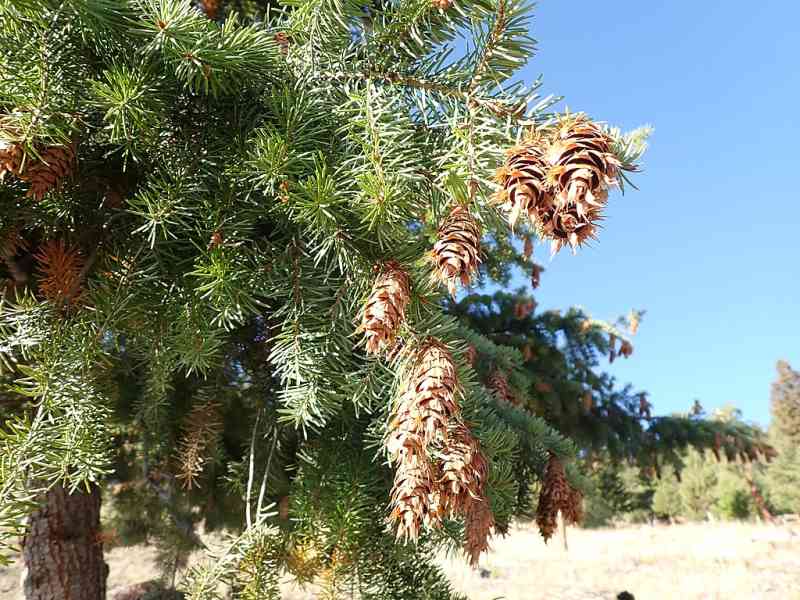
Photo Credit: Matt Lavin / Wikimedia Commons / CC BY-SA 2.0
In the magnificent forests of Washington, the douglas fir reigns supreme as a true giant among trees. Standing tall and proud, it boasts an impressive stature, earning its reputation as one of the largest trees on our planet. This majestic conifer is one of the most important timber species in the United States.
As a young evergreen tree, douglas fir has a narrow and spired pyramidal shape. Its lower branches gracefully droop while the upper ones ascend with determination. When mature, it undergoes a stunning metamorphosis. The once conical form gives way to a cylindrical silhouette, shedding its lower branches until only the top third of the tree remains adorned with verdant foliage.
Plant type: Tree
USDA Hardiness Zone: 5 to 7
Sun: Full sun to partial shade.
Soil: Clay, clay, loam. Acid, neutral. Moist but well-drained.
Duration: Evergreen perennial.
Fragrance: A delightfully sweet scent fills the air when the Douglas fir needles are gently crushed.
Season of interest: All year.
Water needs: Moderate
Mature height: 40 to 80 feet
Maintenance: Low. Keep it well watered since it is intolerant to drought. It is easy to transplant when it is small.
2. Western Red Cedar (Thuja Plicata)
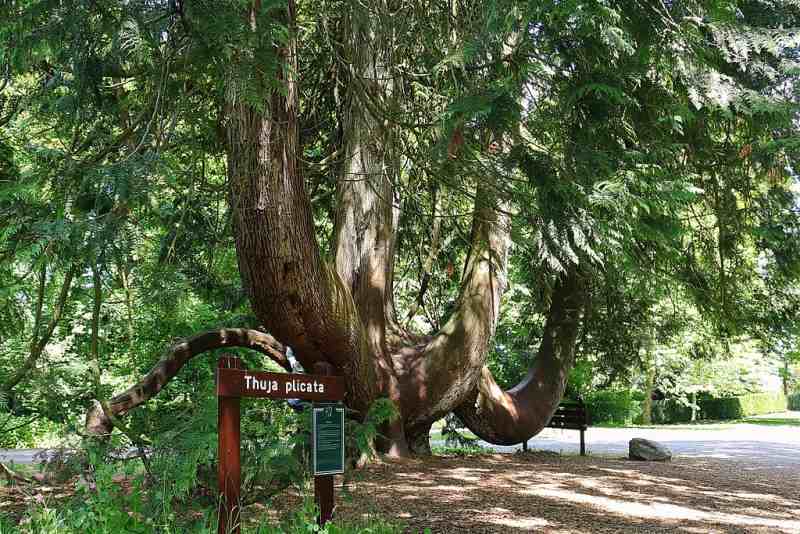
Photo Credit: Robert Linsdell from St. Andrews, Canada / Wikimedia Commons / CC BY 2.0
Deep within the lush forests of Washington, the western red cedar stands as a living testament to the passage of time. With a lifespan that stretches across centuries, some of its elder brethren boast an astounding age exceeding a millennium, proudly bearing the weight of history upon their sturdy branches.
The Western Red Cedar showcases a silhouette that ranges from narrow to broad, resembling a pyramidal shape. This resilient giant may develop a buttressed base. Trees in compact spaces find an elegance in their narrower shape, while those gifted with abundant room embrace a broader form.
Plant type: Tree
USDA Hardiness Zone: 5 to 7
Sun: Full sun to partial shade.
Soil: Moist, fertile, well-drained soils
Duration: Evergreen perennial.
Fragrance: When crushed it emits a distinctive, sweet pineapple or pear drop-like smell.
Bloom time: Spring
Water needs: Moderate.
Mature height: 50 to 70 feet.
Maintenance: Moderate. It does not tolerate drought.
3. Sitka Spruce (Picea Sitchensis)
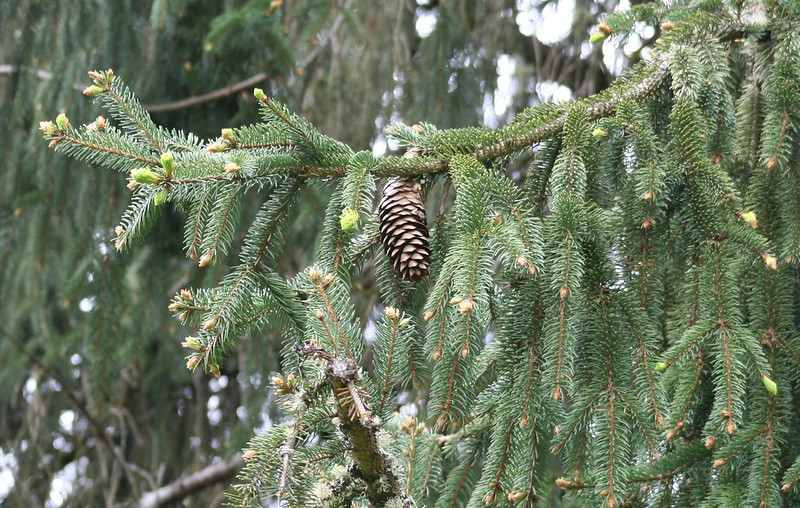
Photo Credit: born1945 / Flickr / CC BY 2.0
In the beautiful woodlands of Washington, the Sitka spruce stands tall. This noble native tree is a sight to behold, with an open crown that reaches towards the sky, adorned with branches that sway and dance. Its vibrant foliage showcases stiff, four-sided needles in a mesmerizing blue-green hue.
The Sitka spruce’s ever-transforming bark changes from smooth and silvery gray in its youth to purplish-brown hues when mature.
Plant type: Tree
USDA Hardiness Zone: 7 to 8
Sun: Full sun.
Soil: Clay, loam, sand. Acid, neutral. Well-drained.
Duration: Evergreen perennial.
Fragrance: Sitka spruce essential oil’s piney, earthy, woodsy scent can offer relief and relaxation during the cold season.
Season of interest: All year
Water needs: Moderate.
Mature height: 50 to 250 feet
Maintenance: Low.
4. Ponderosa Pine (Pinus Ponderosa)
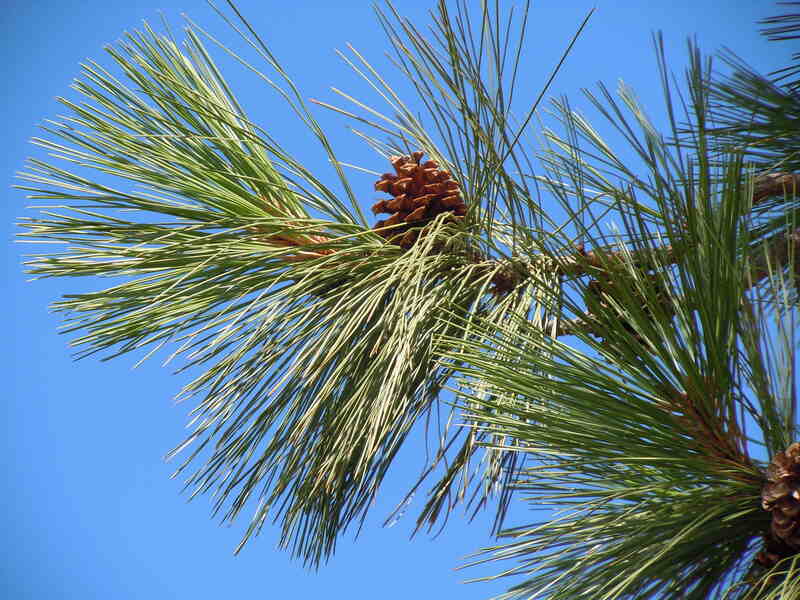
Photo Credit: Matt Lavin / Flickr / CC BY-SA 2.0
The mighty ponderosa pine is a true icon of the Western United States. This magnificent pine stands tall and proud and is known for its dominance and value as a timber resource. Its dark yellowish-green needles, arranged in bundles of three, create a lush and vibrant canopy that captivates the eye.
As we venture closer, we can admire the tree’s fascinating transformation. Young trees boast a striking dark brown to black bark. Yet, as the ponderosa pine matures, its bark evolves into a warm orangish-brown hue adorned with intricate furrows and large scaly plates. Truly a spectacle to behold, this tree embodies strength and resilience.
Plant type: Tree
USDA Hardiness Zone: 3 to 7
Sun: Full sun.
Soil: Chalk, clay, loam, sand. Acid, alkaline, neutral. Well-drained.
Duration: Evergreen perennial.
Fragrance: The bark, stems, and needles emit a resinous or turpentine scent when broken or crushed.
Bloom time: Spring
Water needs: Moderate.
Mature height: 60 to 125 feet
Potential hazards: Induces abortion in cattle.
Maintenance: Low. No tolerance for shade. Established trees tolerate some dry soil conditions.
5. Red Alder (Alnus Rubra)
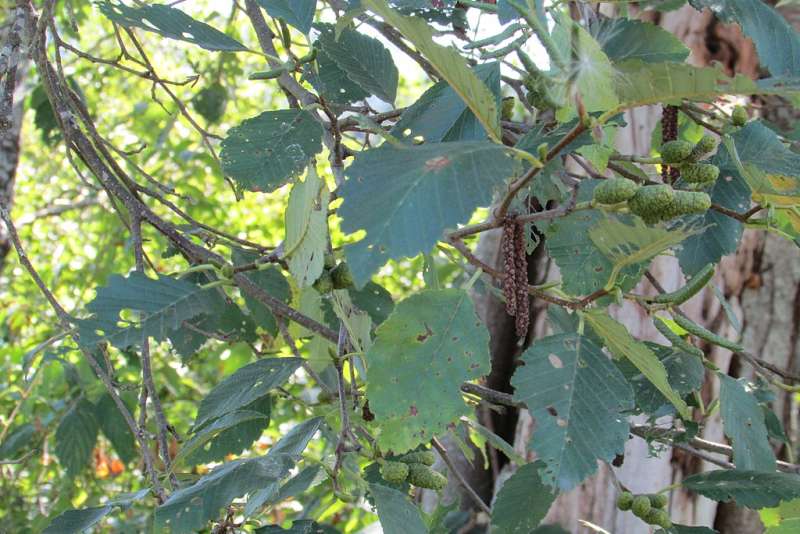
Photo Credit: Chris Light / Wikimedia Commons / CC BY-SA 4.0
This deciduous tree exudes grace and elegance in the forests of Washington. Standing tall with a straight trunk and crowned with pointed or rounded branches, the red alder is a sight to behold. Its bark, adorned in a mottled pattern of light gray to whitish hues, is remarkably smooth to the touch.
But what truly sets this tree apart is its ability to nurture its surroundings. Beneath the surface, they develop intriguing swellings or root nodules housing nitrogen-fixing bacteria, nature’s very own soil enrichers. These bacteria convert atmospheric nitrogen into valuable chemicals that act as natural fertilizers, nourishing the surrounding plants.
Plant type: Tree
USDA Hardiness Zone: 5 to 10
Sun: Full sun, partial sun, shade.
Soil: Clay, chalk, loam, sand. Acid, alkaline, neutral. Moist, but well-drained soil.
Duration: Deciduous Perennial.
Fragrance: The bark has a strong aromatic smell similar to cottonwood.
Season of interest: Spring
Water needs: Wet.
Mature height: 66 to 98 feet.
Maintenance: Low. The growth rate of this tree is quite rapid, and it spreads through the dispersal of its seeds. It favors the combination of cool, wet winters and warm, dry summers for optimal growth and development.
6. Paper Birch (Betula Papyrifera)
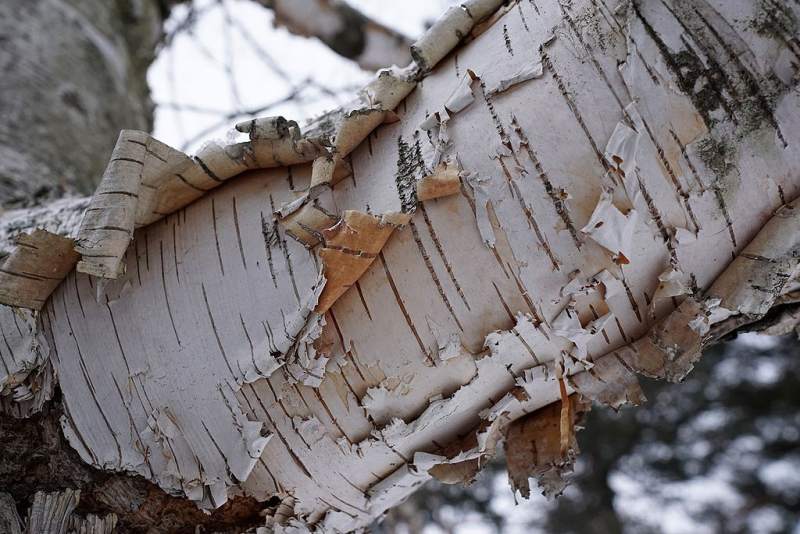
Photo Credit: Plant Image Library / Wikimedia Commons / CC BY-SA 2.0
This tree tells a story with its ever-evolving shape and captivating features. When young, the paper birch takes on a loosely pyramidal form. As it matures, its silhouette transforms into a charming irregular oval to a rounded shape, often retaining low branches.
The paper birch can be trained to grow with multiple trunks, creating a picturesque display. But what steals the show is its exquisite bark. Cloaked in a pristine white coat, it exfoliates gracefully, unveiling strips of papery wonder that reveal a beautiful orange-brown inner bark. Over time, as the tree matures, black markings emerge, painting a stunning contrast on its snowy canvas.
Plant type: Tree
USDA Hardiness Zone: 2 to 7
Sun: Full sun to partial shade.
Soil: Chalk, clay, loam, sand. Acid, alkaline, neutral. Moist but well-drained.
Duration: Deciduous perennial
Fragrance:It has a sweet woody sappy green fragrance.
Season of interest: Spring
Water needs: Moderate.
Mature height: 50 to 70 feet
Maintenance: Moderate.It is better to prune during its dormant season. It is important to avoid pruning during winter or spring when the sap is actively flowing, as it may result in bleeding.
7. Pacific Madrone (Arbutus Menziesii)
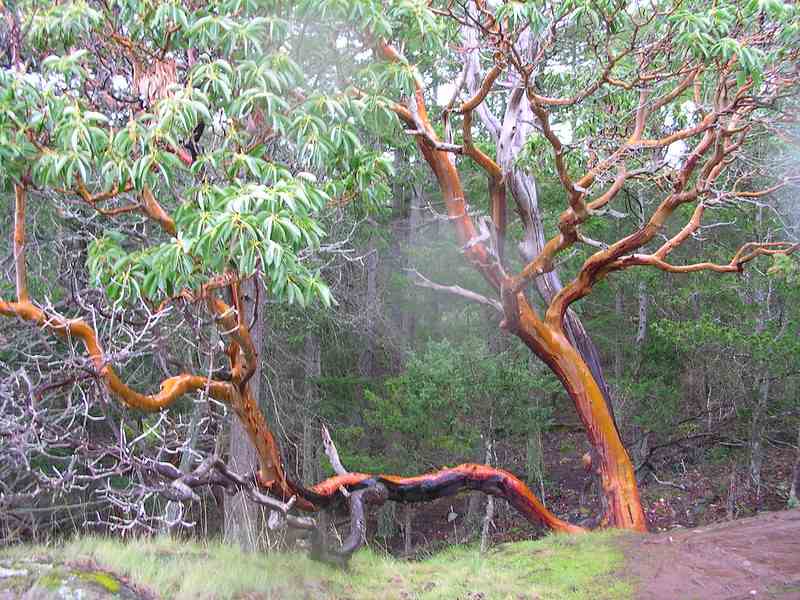
Photo Credit: brewbooks / Flickr / CC BY-SA 2.0
The Pacific madrone is a tree that dazzles the senses with its splendid display of springtime elegance. As the season blooms, this tree adorns itself with white bell-shaped flowers, creating a breathtaking spectacle. But the magic doesn’t end there, for these blossoms give way to round fruits that mature into a striking shade of red, adding a vibrant burst of color to the forest landscape.
The bark sheds its old skin to reveal its true beauty. From its stunning flowers to its fiery fruits and the captivating spectacle of its peeling bark, the Pacific madrone invites us to celebrate the ever-changing nature and find joy in the vibrant tapestry of life.
Plant type: Tree
USDA Hardiness Zone: 7 to 9
Sun: Full sun to part shade.
Soil: Clay, loam, sand. Acid, neutral. Moist but well-drained.
Duration: Evergreen perennial.
Fragrance: It exudes a strong honey smell that attracts bees and fruit-eating birds like waxwings and robins.
Season of interest: Spring
Water needs: Low to moderate
Mature height: 20 to 80 feet.
Maintenance: Low. They are difficult to transplant and can be slow to establish.
8. Pacific Dogwood (Cornus Nuttallii)
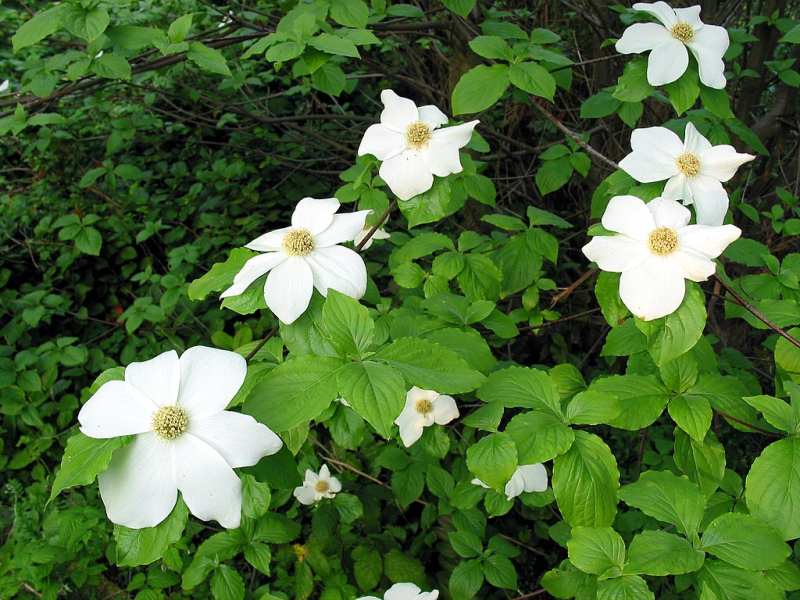
Photo Credit: Paul Schultz from Kenmore, USA / Wikimedia Commons / CC BY 2.0
The Pacific dogwood tree presents itself with a dense, conical, or rounded crown. Its branches, arranged in a graceful, horizontal-tiered fashion, create a picturesque display that evokes a sense of serenity and harmony. The Pacific dogwood has delicate, white flowers.
As the seasons shift, the Pacific dogwood continues to delight. It adorns itself with orange to red fruits, adding a touch of autumnal splendor to the landscape. And when the foliage begins its transition, the tree’s leaves transform into a captivating shade of yellow-orange, painting the surroundings with a vibrant burst of color.
Plant type: Tree
USDA Hardiness Zone: 7 to 9
Sun: Full sun to partial sun.
Soil: Loam, sand. Acid, neutral. Moist but well-drained.
Duration: Deciduous perennial
Fragrance: It has a strong but pleasant floral scent similar to sweet honeysuckle.
Season of interest: Spring
Water needs: Moderate
Mature height: 15 to 40 feet
Maintenance: Moderate. Established plants have some drought tolerance.
FAQ About Trees Native to Washington State
In the vast landscapes of Washington, the western red cedars claim the title of the state’s towering giants. These majestic evergreen conifers dominate the coastal regions, reaching impressive heights of 100 to 200 feet and boasting 9 feet or more diameters.
Here’s a list of other native tree species in Washington:
• Vine Maple (Acer circinatum)
• Western Hemlock (Tsuga heterophylla)
• Oregon ash (Fraxinus latifolia)
Where to Find Native Plants and Trees in Washington State
When embarking on a backyard landscaping project in Washington, tapping into the expertise of local nurseries becomes crucial. Opting for native trees and plants from these nurseries ensures they are well-suited to the region’s climate and soil conditions, enhancing their resilience and long-term maintenance.
Remember that Washington State predominantly falls under USDA hardiness zones 7 and 8, with average minimum temperatures ranging from 5 to 20 degrees Fahrenheit. However, selecting suitable plants or trees is the first step in creating a thriving landscape. Ongoing care and maintenance are vital for its sustained health and vitality.
To ensure the best results for your yard, consider hiring a lawn care pro near you to handle the mowing, trimming, and edging. We can connect you with trusted pros in Seattle, Tacoma, Spokane, and many other cities throughout the state.
Main Photo Credit: The Washington State Capitol Building / Pastajosh / Wikimedia Commons / CC BY-SA 4.0